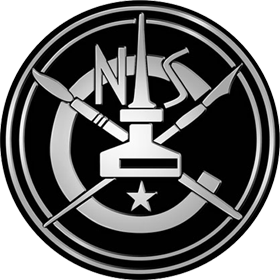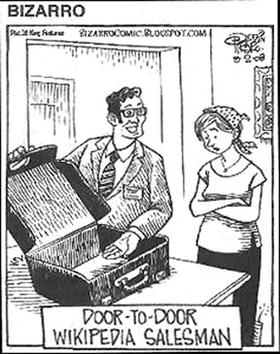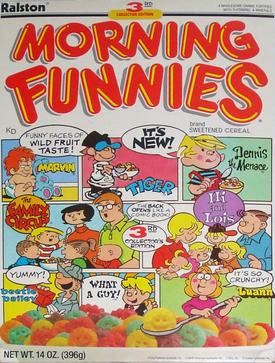
A comic strip is a sequence of cartoons, arranged in interrelated panels to display brief humor or form a narrative, often serialized, with text in balloons and captions. Traditionally, throughout the 20th and into the 21st century, these have been published in newspapers and magazines, with daily horizontal strips printed in black-and-white in newspapers, while Sunday papers offered longer sequences in special color comics sections. With the advent of the internet, online comic strips began to appear as webcomics.

A cartoon is a type of visual art that is typically drawn, frequently animated, in an unrealistic or semi-realistic style. The specific meaning has evolved, but the modern usage usually refers to either: an image or series of images intended for satire, caricature, or humor; or a motion picture that relies on a sequence of illustrations for its animation. Someone who creates cartoons in the first sense is called a cartoonist, and in the second sense they are usually called an animator.

The National Cartoonists Society (NCS) is an organization of professional cartoonists in the United States. It presents the National Cartoonists Society Awards. The Society was born in 1946 when groups of cartoonists got together to entertain the troops. They enjoyed each other's company and decided to meet on a regular basis.

Bizarro is a single-panel cartoon written and drawn by cartoonist Dan Piraro and later by cartoonist Wayne "Wayno" Honath.

William Aloysius "Bil" Keane was an American cartoonist most notable for his work on the newspaper comic The Family Circus. It began in 1960 and continues in syndication, drawn by his son Jeff Keane.

The Newspaper Enterprise Association (NEA) is an editorial column and comic strip newspaper syndication service based in the United States and established in 1902. The oldest syndicate still in operation, the NEA was originally a secondary news service to the Scripps Howard News Service; it later evolved into a general syndicate best known for syndicating the comic strips Alley Oop, Our Boarding House, Freckles and His Friends, The Born Loser, Frank and Ernest, and Captain Easy / Wash Tubbs; in addition to an annual Christmas comic strip. Along with United Feature Syndicate, the NEA was part of United Media from 1978 to 2011, and is now a division of Andrews McMeel Syndication. The NEA once selected college All-America teams, and presented awards in professional football and professional [NBA] basketball.

The Lockhorns is a United States single-panel cartoon created September 9, 1968 by Bill Hoest and distributed by King Features Syndicate to 500 newspapers in 23 countries. It is continued today by Bunny Hoest and John Reiner.
Bunny Hoest, sometimes labeled The Cartoon Lady, is the writer of several comic strips, including The Lockhorns, Laugh Parade, and Howard Huge, the first of which she inherited from her late husband Bill Hoest. She is the co-creator of Bumper Snickers in 1974, Agatha Crumm in 1977, Laugh Parade in 1980, Howard Huge in 1981, What A Guy! in 1986, and Hunny Bunny's Short Tales in 1992.

Laugh Parade was a group of weekly gag cartoons written by Bunny Hoest and drawn by John Reiner. It ran in Parade, a Sunday newspaper magazine supplement.

John Reiner is a cartoonist who collaborates with writer Bunny Hoest on three cartoon series: The Lockhorns, syndicated by King Features, and Laugh Parade and Howard Huge.

William Pierce Hoest was an American cartoonist best known as the creator of the gag panel series, The Lockhorns, distributed by King Features Syndicate to 500 newspapers in 23 countries, and Laugh Parade for Parade. He also created other syndicated strips and panels for King Features.

Our Boarding House is an American single-panel cartoon and comic strip created by Gene Ahern on October 3, 1921 and syndicated by Newspaper Enterprise Association. Set in a boarding house run by the sensible Mrs. Hoople, it drew humor from the interactions of her grandiose, tall-tale-telling husband, the self-styled Major Hoople, with the rooming-house denizens and his various friends and cronies.

Jay Malcolm Kennedy was an American editor and writer. The author of The Official Underground and Newave Comix Price Guide, he was a long-time editor at King Features Syndicate, eventually rising to the position of editor-in-chief.

Agatha Crumm is a newspaper comic strip created by the cartoonist Bill Hoest and distributed by King Features Syndicate. The strip ran from October 24, 1977, until 1997. Agatha Crumm was Hoest's third strip, following Bumper Snickers (1974).
A comic strip syndicate functions as an agent for cartoonists and comic strip creators, placing the cartoons and strips in as many newspapers as possible on behalf of the artist. A syndicate can annually receive thousands of submissions, from which only two or three might be selected for representation. In some cases, the work will be owned by the syndicate as opposed to the creator. The Guinness World Record for the world's most syndicated strip belongs to Jim Davis' Garfield, which at that point (2002) appeared in 2,570 newspapers, with 263 million readers worldwide.
Allan Holtz is a comic strip historian who researches and writes about newspaper comics for his Stripper's Guide blog, launched in 2005. His research encompasses some 7,000 American comic strips and newspaper panels. In addition to his contributions to Hogan's Alley and other publications about vintage comic strips, he is the author of American Newspaper Comics: An Encyclopedic Reference Guide (2012). He is a resident of Tavares, Florida.

Morning Funnies is a fruit-flavored breakfast cereal produced by Ralston Cereals in 1988 and 1989. The name of the cereal was based on the assortment of newspaper comic strips featured on the box. Innovative packaging allowed the back flap of the box to be opened revealing additional comic strips, different on each edition of the cereal box. Poor sales and negative consumer reaction led to the cereal being discontinued in 1989.

Penny was a comic strip about a teenage girl by Harry Haenigsen which maintained its popularity for almost three decades. It was distributed by the New York Herald Tribune Syndicate from June 27, 1943, to October 25, 1970.
Quincy is an American syndicated newspaper comic strip published from July 13, 1970 to October 4, 1986, created and produced by cartoonist Ted Shearer. The series, about an African-American boy being raised by his grandmother in Harlem, was one of the earliest mainstream comic strips to star an African American in the lead role, following Dateline: Danger! (1968-1974) and Luther (1969-1986). Another predecessor, Wee Pals, features an African-American among an ensemble cast of different races and ethnicities.
Chronicle Features was the syndication arm of the San Francisco Chronicle. Syndicating comic strips, newspaper columns, and editorial features, it operated from 1962 to c. 1998. The syndicate was known for the offbeat comic strips it championed, such as Gary Larson's The Far Side, Dan Piraro's Bizarro, and the editorial cartoons of Ted Rall. The service was acquired by Universal Press Syndicate in 1997 and went defunct soon after.















